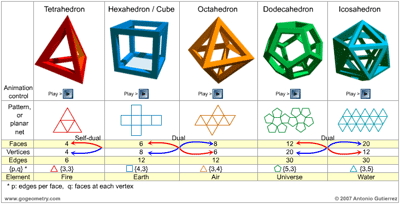|
Instructions: To control the animation of each
platonic solid, press the STOP/PLAY button
Theaetetus' Theorem (ca. 417 B.C. – 369 B.C.) There are precisely five regular convex polyhedra
or Platonic solid.
A platonic solid is a polyhedron all of whose faces are
congruent regular polygons, and where the same number of faces
meet at every vertex. A polyhedron is a solid figure bounded by
plane polygons or faces.
The Greek philosopher Plato described
the solids in detail in his book "Timaeus" and assigned the
items to the Platonic conception of the world, hence today they
are well-known under the name "Platonic Solids."
Euler's polyhedron theorem: F + V = E
+ 2,
where F, V, E are the number of faces, vertices, and edges in
the polyhedron.

|